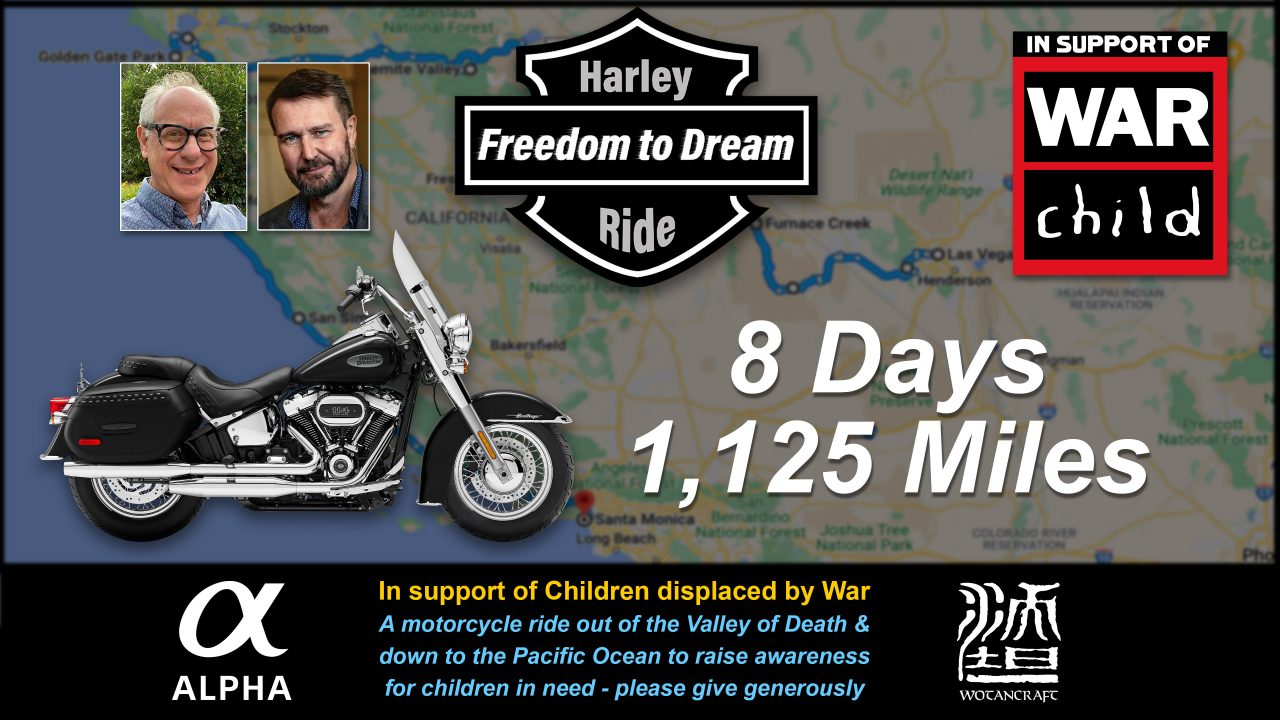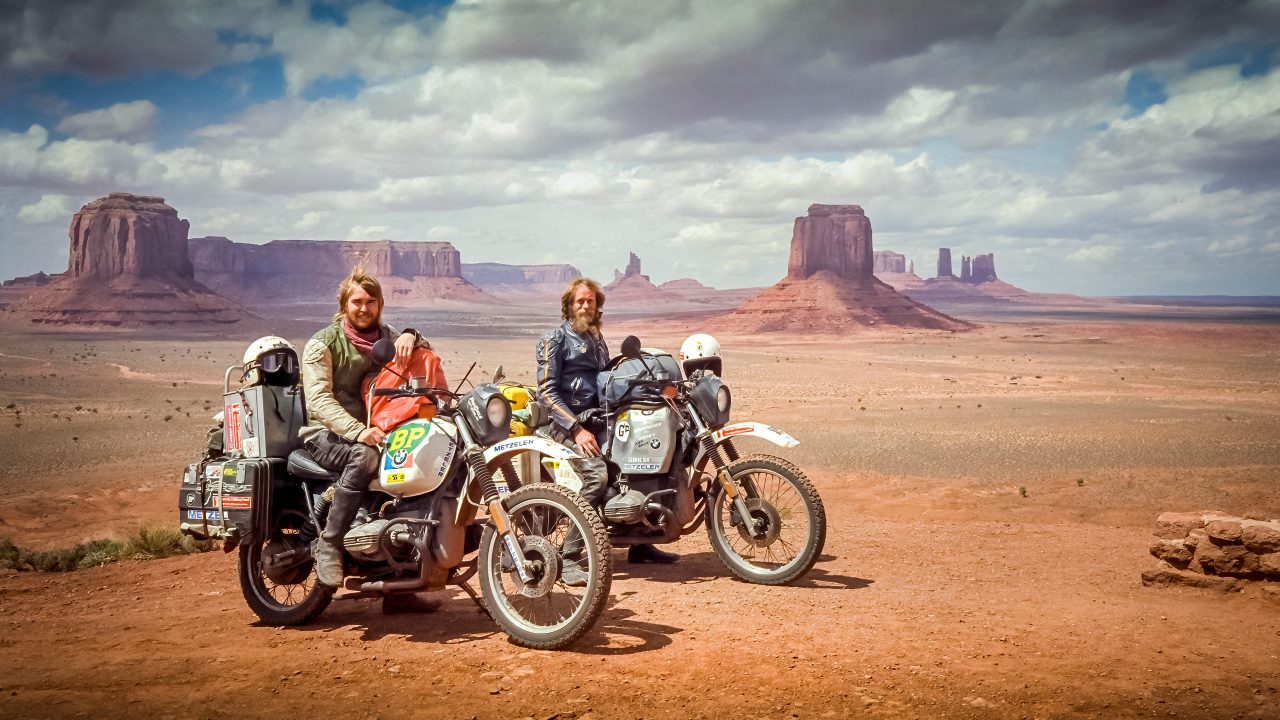Blog
Faith, Hope and Charity: Part Three
Being the final thrilling instalment of the round-the-world trip that gripped Neasden (a non-consequential suburb in north London)
Bouncing around in the back of a Ford pickup with bulbous wings, huge wheels and the obligatory dirty white paint job, we looked across the huge expanse of land to our east and started to get an impression of how much space there is in Australia.
Qantas had come up with the goods in Bali and flown the bikes across, at cost price, to Perth. They’d shared their air pallet with a second World War Harley, and it was the proud new owner’s father’s pickup in which we were being trundled from office to office to free our bikes from over-possessive Aussie customs. They’d built the relevant offices for the airport and customs miles away from each other – they had the space, and they were bloody well going to use it, mate!
Extracting ourselves from Customs the day before had been a game in itself. Trying to get through immigration in grubby leathers, clutching tattered saddlebags, surrounded by hordes of Australian surfers pretty well guaranteed the evil eye from the uniformed brigade. Our luggage didn’t look remotely like surfboards, and where was the zinc cream and Bali shorts, not to mention the incipient melanomas? We were quite obviously international drug smugglers or PLO Hells Angels. Dog-eared passports crammed with the history of the last 12 months through 21 countries didn’t impress them at all, so our offbeat luggage was earmarked for special attention and systematically taken apart. By the time they’d finished squeezing our toothpaste tubes, rummaging through our smalls and snorting, then confiscating our milk powder, we were the only people left at the airport who didn’t work there.
Until a week before arriving in Oz our address book for Perth had been a little empty. But now it included the alleged whereabouts of one Rick Carter, a nice guy with whom we’d got horribly drunk on distilled palm sap in a Balinese bar – but would he remember us? Would he remember anything!
We gave him a ring and he offered to pick us up (despite admitting to wondering who the hell we were), but thought we must have been Ok if he’d given us his address. The drive home in Rick’s old stick-shift V8 Holden showed Perth to be an interesting mix of English and American cultures: freeways and fish & chips.
Once the bikes were certified free from anything appertaining to Asia (ie bugs, drugs and boat people), they were free to set rubber on Aussie dirt. Well, almost. We spent the next week raising money for the charities whilst trying to make amends to both bikes for the abuse inflicted on them: Max straightening the front end of his and Mark helicoiling the cylinder studs which had stripped from the crash in Sumatra.
Having originally intended to arrive from Indonesia at Darwin in the Northern Territories, we were now the small matter of two and a half thousand miles adrift. We could rejoin our original route by a choice of two sealed roads, but were diverted by reports of good money to be earned in the gold mines out in the outback. We decided to check this out before tackling the infamous Gun Barrel Highway – a rough unsealed track forged across the outback to Uluru (temporarily renamed Ayers Rock by the British after colonisation) in the red centre of the country.
This is the land where sealed roads are called ‘the bitumen’, afternoons are ‘Arvos’, roughnecks are ‘Ockers’, distances between places are measured in slabs (cases of beer drunk on the way), and driving across the outback is “goin’ up the guts’ mate!”
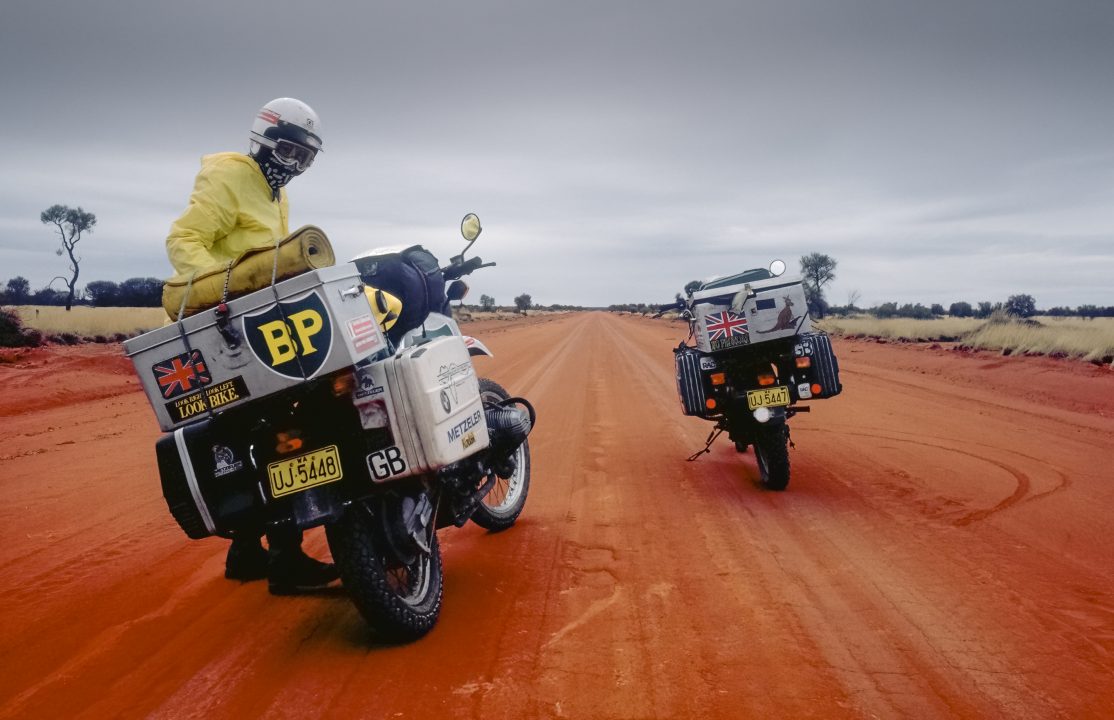
The bitumen finally petered out at a small mining town called Laverton. 40 kilometres further on we hit our first deep sand at around 60mph. The bike, the speedo, the ignition and Mark all went in spectacularly different directions, which Max had to gather up and stick back together. The bike wasn’t too big a problem once he’d found the ignition switch buried in the sand, but Mark wasn’t so lucky. With torn muscles, ligaments and a broken shoulder (although we didn’t discover that until we returned to Blighty), we had no choice but to struggle painfully back to Laverton where the doc, with a strong odour of whiskey on his breath, said “she’ll be right, mate!” and told him to rest.
Mark took the doc’s advice and put Max to work in a nearby gold mine while he pushed the odd drop of amber muscle relaxant down his throat in the town’s only pub, aptly named ‘The Desert Inn’. The next pub east of this one was nearly a thousand miles away. It made you thirsty just thinking about it.
Six weeks later, with a weak arm, 20 gallons of fuel, 3 gallons of water and baked-beans-a-plenty we tried again. Next stop an Aboriginal reserve 350 miles out in the bush. If Australia is the final frontier and this was our ‘Bush Trek’, what we’d like to know is where was Scottie when we needed him to beam us up when we were in the middle of it all. Six years-worth of falling off in six days as we bumped, bounced, weaved and dug our way out of the bush to the bitumen at the other end.
With an all-up weight of over 250kgs (550 lb) apiece and far too much weight on the front end, we hardly had what you might call the ideal off-road bikes. The corrugations were vicious, cracking Max’s triple clamp and leaving him with a seriously puny and delinquent front end. Mark’s voltage regulator packed up along with the universal joint on the shaft and one of the panniers split open, just enough to let out one item per two hundred metres over several kilometres until empty. We rode ten-hour days, covering an average of just 120 miles per day. At least the bugs weren’t a problem – most of them overtook us.
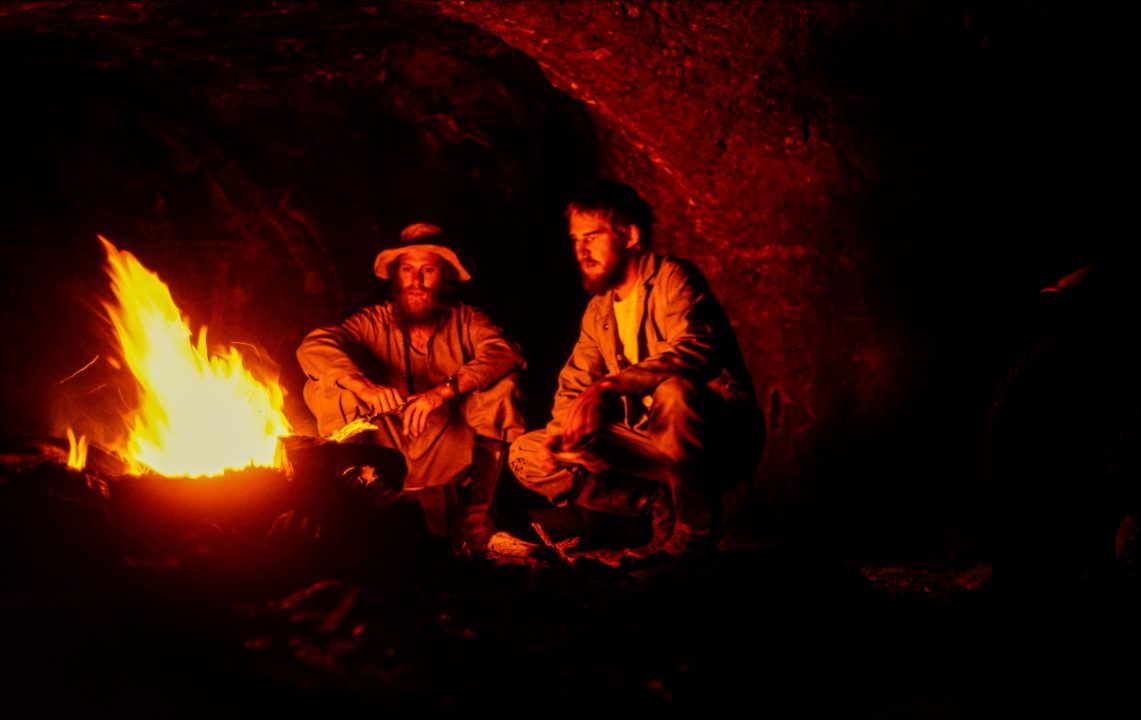
The first night we camped in an Aboriginal cave where flocks of cockatoos came to roost at sunset. It was a strange feeling to think that there probably wasn’t another (sane) human being within a hundred miles in any direction. From there on we camped out, laying our bedroll out by an open fire and falling asleep whilst the Southern Cross slid silently across the clear starry sky.
Whoever created Aussie wildlife clearly had a sense of humour. The stuff we met was always bizarre and usually dramatic, from being buzzed by budgies to nearly being broadsided by a six foot red ‘roo’ in full hop, or run into by an erratic emu.
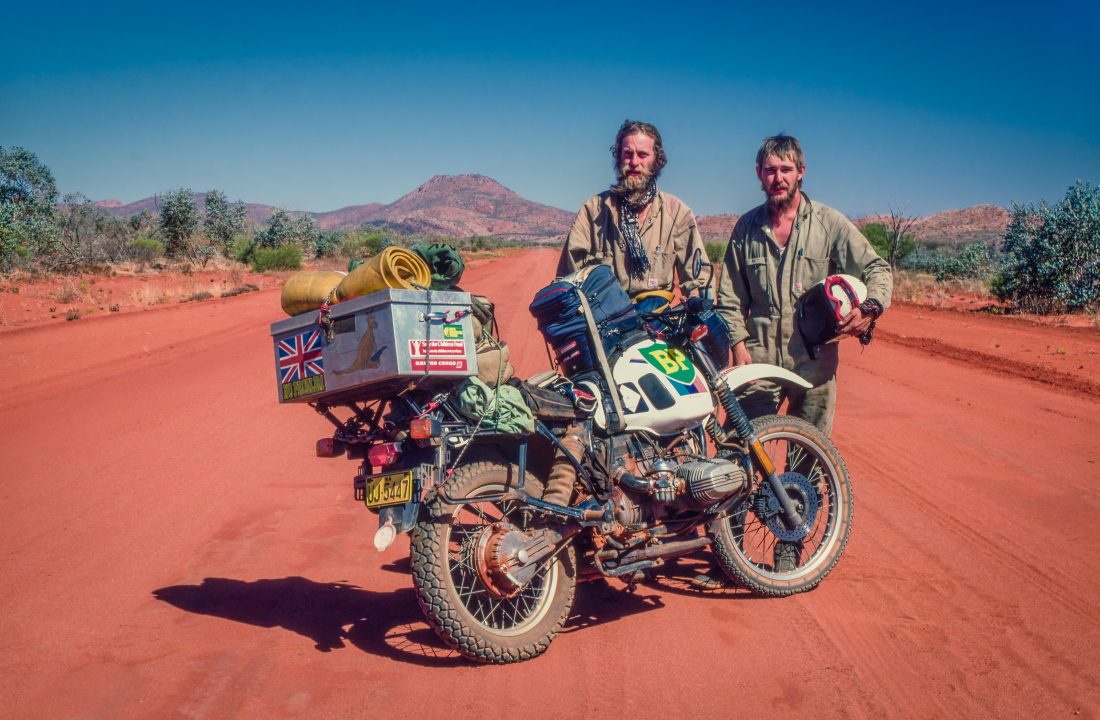
By luck rather than good sense we came out the other end at Uluru, a sacred site for the Aborigines, and the largest monolith in the world. The ordeal gave us a whole new outlook on the simple commodities it’s all too easy to take for granted – such as water, a comfortable armchair, a cold beer and most of all bitumen! They don’t call the Gun Barrel Highway, GBH for nothing.
We recovered in Alice Springs, fixed the bikes up yet again and even had time to take in some of what passes for local culture. Such as ‘Baked Bean Gargling’ at the ‘Bulldust’ bike rally and the boat races at the Henley-on-Todd regatta (an Australian comedic version of the Henley-on-Thames regatta). You’d have thought that the Todd river, being dry for most of the year, imposes a certain handicap, but not a bit of it: the eight man crews just run up and down the dry river bed in bottomless boats with temperatures reaching the 100s. And they say only mad dogs and Englishmen…
From Alice we headed North, then East across open bush, but this time on beautiful bitumen. The only obstacles now were the road trains – huge, foot-to-the-floor trucks towing up to five trailers. The road was usually only wide enough for one vehicle so when these monsters dropped one set of wheels onto the dirt the sun went out.
Eventually the bush gave way to the grasslands of Queensland and then to the Atherton tableland – rolling pastures, waterfalls and tropical rain forest. Even more shocking than seeing the colour green again (especially for Max’s nose which has a distinct dislike for pollen), was finding bitumen that wasn’t straight from horizon to horizon. A beautifully windey road took us down off the tablelands to Cairns and the Pacific Ocean.
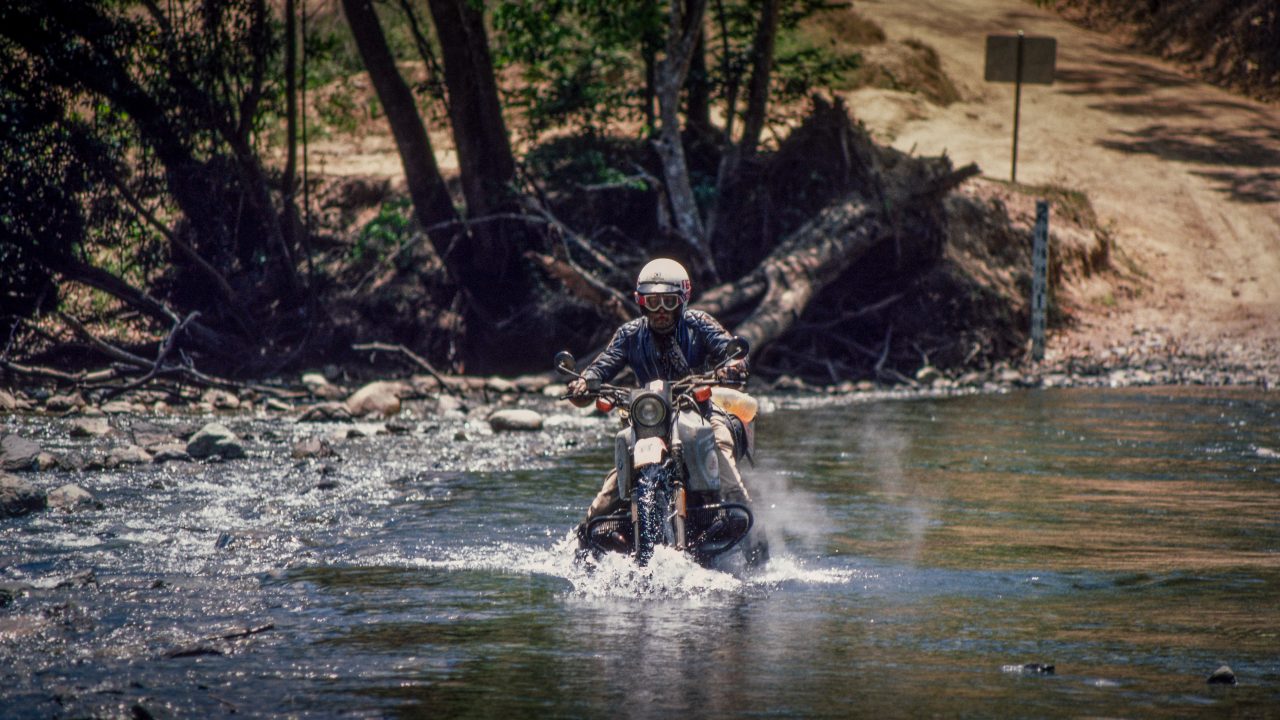
Leaving the bulk of our luggage at Cairns we then tackled the Daintree track to Cooktown in the North. This takes you through thick rain forest, where the creeks are full of crocs and the crocs are full of unwary tourists. Then there’s the bulldust, a fine powder which kicks up in great clouds behind you. The only danger with the stuff (apart from the person travelling behind, choking on it) is that it blows across the track, filling in potholes. The result was a lot of grubby fun, a split fuel tank, broken frame rail and a broken luggage rack.
South of Cairns the Pacific Highway gave us a clear run down the eastern seaboard through Queensland and New South Wales. With oil leaking from the right hand cylinder of Mark’s bike (the helicoils hadn’t held), and the shock’s damping just a vague memory, we rode into Sydney in the worst rains the city had seen in forty years. A drenched police escort met us and led us to Sydney Opera House where we were welcomed by the Down Syndrome Association and BP Australia.
Publicity seemed to be the order of the day now as we hit the TV, radio and papers in Canberra, Melbourne and Adelaide. BMW Australia helped us sort the bikes for the second of the World’s great coast roads The Great Ocean Road between Melbourne and Adelaide.
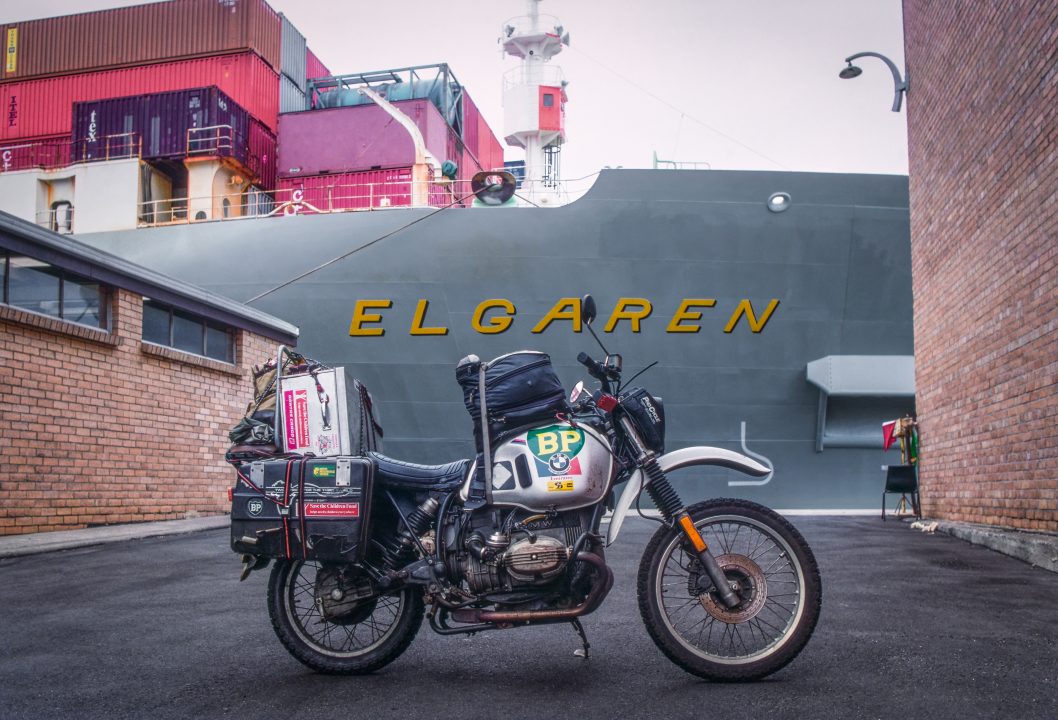
As we waited for spring to arrive in the Northern Hemisphere we began the search for a ship to take us across the Pacific. The pressing need now was to get back home with very little money left. We eventually struck lucky with a Swedish freighter whose captain agreed to take us and the bikes to Los Angeles for exactly the right price: nothing.
As we left Australia at the beginning of their Autumn we couldn’t help thinking that our ancestors had made a big mistake. They should have shipped the population of Great Britain out to Australia and left the convicts on that tiny, miserable, wet and cold island in the North Atlantic.
By contrast Los Angeles was hot, dirty, smoggy, violent and expensive, but fate came to the rescue when Max’s cousin turned out to be a film producer in Beverley Hills. From his heated swimming pool LA took on a whole new appearance. A comparable stroke of luck gave us a free stand at the US motorcycle grand prix, from where we managed to raise over £1500 by raffling off a helmet signed by all the Grand Prix stars with a little help from Randy Mamola (the current world champion).
We’d basked in truly beautiful weather since our arrival in California and were just beginning to pat ourselves on the backs for our excellent management of world climate (having entirely missed a winter) when the sky caved in on us.
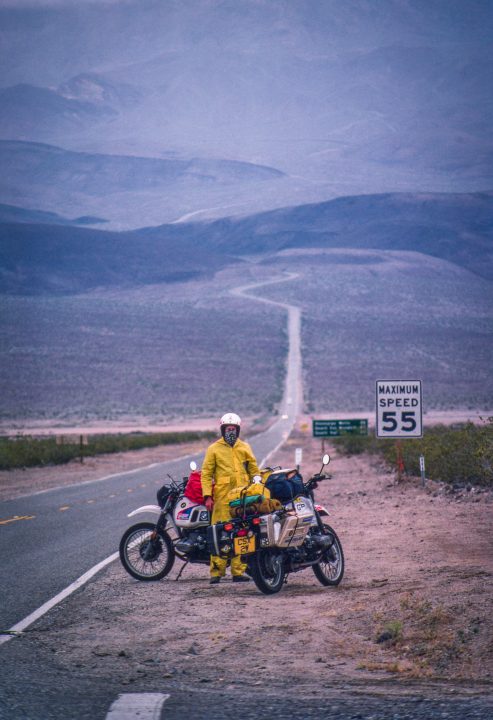
To get into the desert to the east of California you first have to cross the Sierra Nevada, a mountain range between the two. Our first attempt was at Yosemite, but we were turned back by heavy snows on the mountain passes. We were forced South, pass-by-pass, until we found one – Badger Pass – that was just about open. It was the first snow we’d seen in a year and made us wonder if we were travelling in the right direction. From here we dropped into Death Valley, normally the hottest place on earth, on the very day when two whole years’ rainfall chose to drop. Riding along pushing bow waves from the Bee-eMs, it was hard to believe people had died of thirst in this place. A generous Texan rode with us from here to Vegas on his RT, bought us a meal at a casino and later paid for a motel room when, en route for the Grand Canyon in Arizona, we were attacked in the desert by a vicious rainstorm. The world was going mad.
The next morning the Texan headed South, we headed North and were greeted by one of the truly remarkably sights of the world, the Grand Canyon. Next we were in Indian country, some of it strangely familiar, Monument Valley being stamped in the mind of everyone by John Ford and John Wayne. Riding around the desert tracks you half expect a stagecoach to come hurtling past with Geronimo in hot pursuit.
For the last few days we’d been reduced to a diet of cheese sandwiches, so when we crossed into New Mexico we asked the old address book to inflict us on some people in Albuquerque whom we’d met at Laguna Seca (US MotoGP). Having slept in their children’s beds and emptied their fridge, we moved on. The book’s next victim was in Dallas, Texas – the RT rider with a generous streak a mile wide. He was over seven hundred miles away but that’s as good an excuse as any for a long ride.
Now Texans are hospitable. This guy had gone to his local liquor store and asked if they had any warm flat beer. They looked at him like he was daft and gave him some ‘Limey stuff’ called ‘Ruddles’ out of the fridge. He promptly took it home and put it in the Texas sun to warm up.
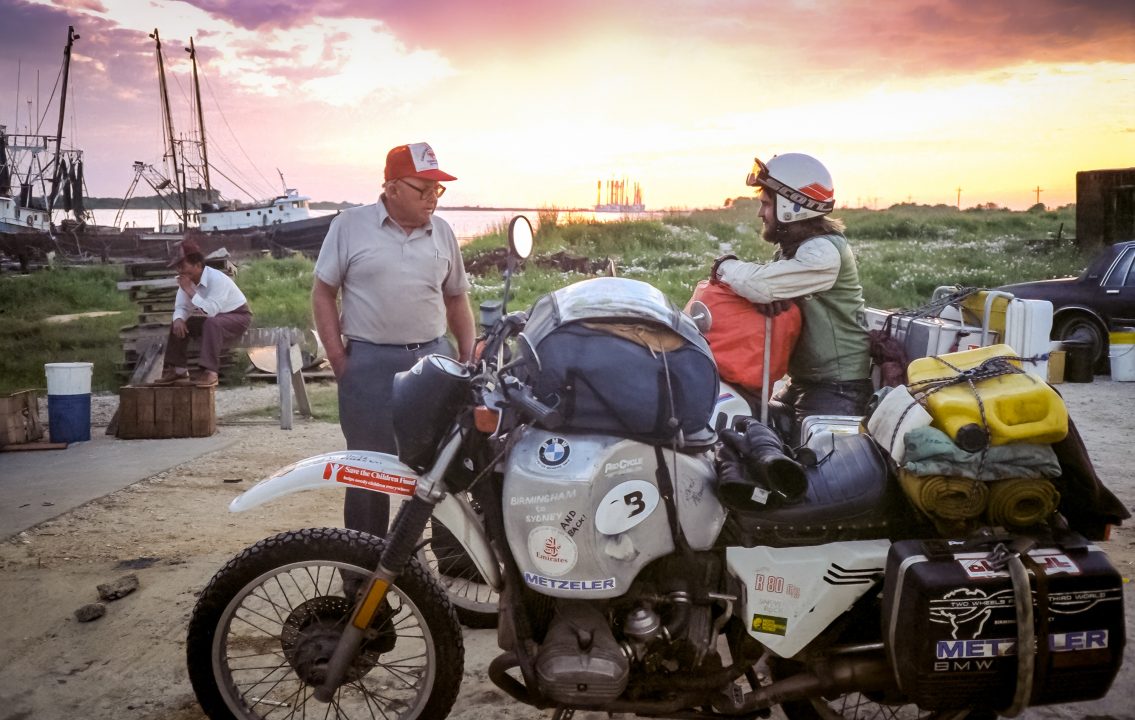
In the Bayou country between Texas and Louisiana – where the cops call you ‘Boy’ and you call them ‘Sir’ – we camped by a river in a cloud of mosquitos. The owner of the land dropped by to see us in his four-wheel drive: “Y’all’re welcome ter stay here, boys, an’ don’ let nobuddy move y’on. This land’s all mine frum th’bridge ‘n’ th’river as furrrrs y can see that way ‘n’s furrr’s y’can see that way. ” He pointed in the relevant directions. “Just one thing, boys,” he added as an afterthought, “ah’ll advise y’all not ter move around too much after’n’ it gets dark. Ah’ve got a two barrel twelve bore ‘n’ a…” A list of hefty armory ensued. “Anyways boys, Y’all’ll be needin’ to get a fire in to keep the skeeters at bay so if ‘n’ y’all jump in th’truck, ah’ll show yer some wood” It sort of seemed like an offer we couldn’t refuse.
We arrived in New Orleans (correctly pronounced ‘N’awlins”), and made our way to the French Quarter and the home of Arnold. Arnold had passed away down Mexico way at Christmas while riding his BMW at the age of seventy-seven, but his memory and his hospitality lived on. Anyone passing through New Orleans on a BMW was welcome at Arnold’s place, the welcome being extended by his son Krekel and daughter Kalish. Arnold had passed his love of motorcycles down to his kids, Krekel picking up his first speeding ticket at the age of ten with his dad, fast asleep, riding pillion.
We hung around to catch the Jazz Festival before heading North beside the Mississippi through the Natchez Trace parkway to Nashville, Tennessee. It was Sunday; Nashville didn’t appear to be open, so we headed into the Smoky Mountains of North Carolina to the east to pick up the Blue Ridge Parkway – 469 miles of uninterrupted twisties with not a single give way or red light. The Parkway sucked us ever onward into the Blue Ridge Mountains of Virginia and finally spat us out into the Shenandoah mountain range South-West of Washington DC.
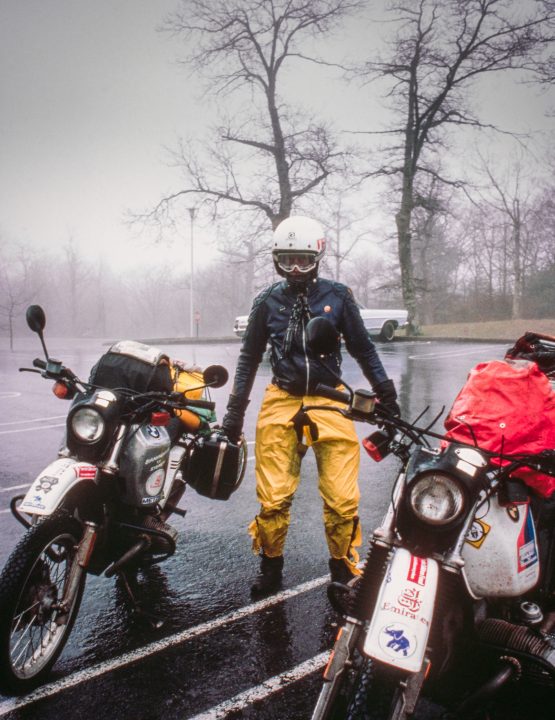
Hitting torrential rain and mist in the Shenandoah Mountains, without a decent set of waterproofs between us, meant hitting Washington drenched and frozen but we still had our life-saving little book of addresses. It revealed one last strategically-placed cousin whose kitchen and bathroom were about to be hi-jacked.
With our coming home party already organised back in England a call to the docks in New York miraculously found a ship due to leave that afternoon. One puncture and eight hours later we’d set sail for Liverpool, working our passage across the Atlantic. We not only arrived back in time for our reception but we also made the Isle of Man and the British Grand Prix – where we finally got rid of the helmet which had been with us from Laguna Seca, raising another £1,000 for Save the Children and the Down Syndrome Association.
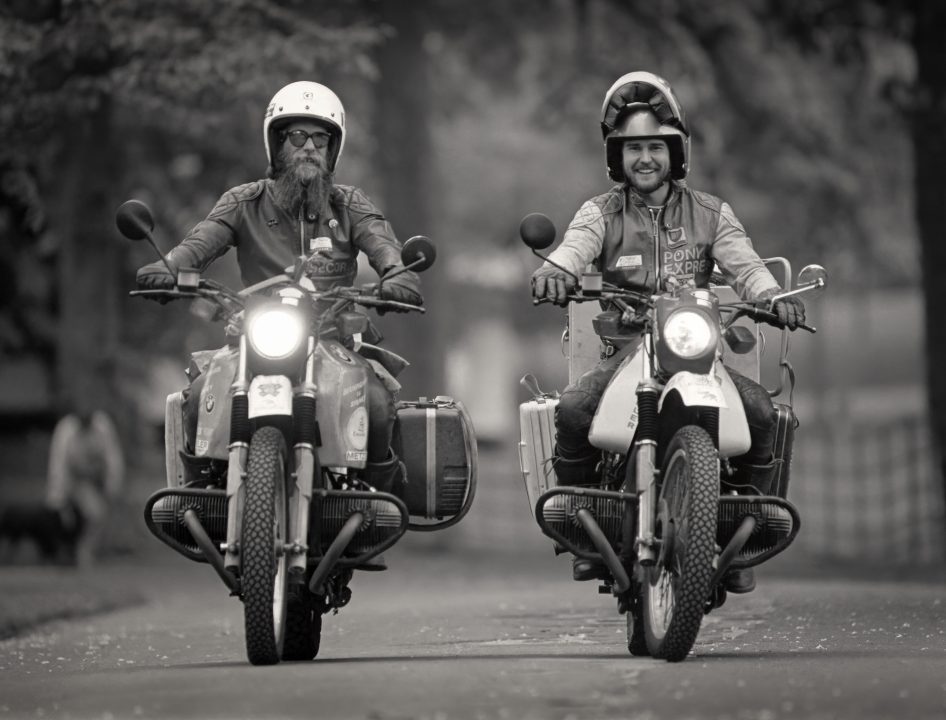
Total: £16,000, 42,000 miles, 22 months and more adventure than most lifetimes see.
View the Photo Album from the Trip: https://adobe.ly/3QTpi16
